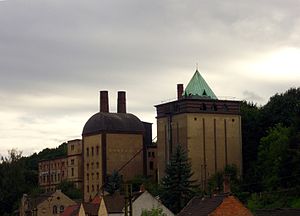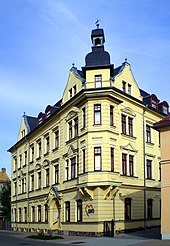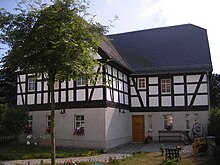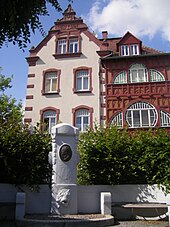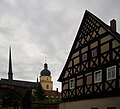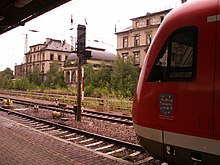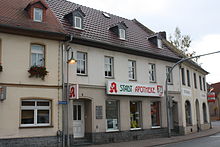Gößnitz (Thuringia)
| coat of arms | Germany map | |
|---|---|---|
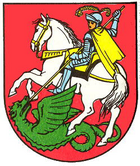
|
Coordinates: 50 ° 53 ' N , 12 ° 26' E |
|
| Basic data | ||
| State : | Thuringia | |
| County : | Altenburger Land | |
| Fulfilling municipality : | for Heyersdorf for Ponitz |
|
| Height : | 202 m above sea level NHN | |
| Area : | 14.07 km 2 | |
| Residents: | 3386 (Dec. 31, 2019) | |
| Population density : | 241 inhabitants per km 2 | |
| Postal code : | 04639 | |
| Primaries : | 034493, 03764 (Hainichen) | |
| License plate : | ABG, SLN | |
| Community key : | 16 0 77 012 | |
| City structure: | Core city; 5 districts | |
City administration address : |
Freiheitsplatz 1 04639 Gößnitz |
|
| Website : | ||
| Mayor : | Wolfgang Scholz (Initiative City Association) | |
| Location of the city of Gößnitz in the Altenburger Land district | ||
Gößnitz [pronunciation: gœsnɪt͡s ] is the smallest city in terms of population and the second smallest city in terms of area in the Altenburger Land district in Thuringia . The country town is best known for the railway junction of the Leipzig – Hof rail connection and the Central-Germany connection ( Glauchau-Schönbörnchen-Gößnitz and Gößnitz-Gera ) as well as the annual Gößnitz Open Air since 1993 . The city experienced its greatest boom at the time of industrialization, so the representative malt factory Viktor Grimm's successor from 1889 still shapes the cityscape today.
geography
Geographical location
Gößnitz is the easternmost city in Thuringia and the southernmost in the Altenburger Land. The Meerchen flows through the city, which flows into the Pleiße in the south , the place is located in the transition area from the Erzgebirge foreland to the Leipzig lowland bay .
Neighboring communities
Neighboring communities are in the north Nobitz with the districts Taupadel and Bornshain in the west, Löhmigen in the north, Goldschau in the northeast and Podelwitz , Runsdorf and Zumroda in the east, in the southeast Schönberg and Meerane in the Saxon district of Zwickau , in the south Ponitz with the districts Merlach and Zschöpel and Schmölln with the districts of Nitzschka and Kummer in the west.
City structure and incorporations
- Hainichen in the southwest since 1923
- Kauritz partly since August 1, 1924 and 1928 in the south
- Nörditz since July 1, 1950 in the west
- Parish village in the east since November 1, 1973
Untergötzenthal belonged to Gößnitz between 1922 and the reclassification to Meerane in Saxony in 1928.
history
13th to 19th centuries
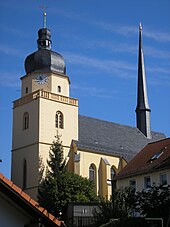
Gößnitz was first mentioned in a document in 1253 as an imperial knight seat. It is assumed that a Sorbian village was founded, as the place name Gößnitz is of Sorbian origin. From 1328 Gößnitz was under Markmeissnian rule and in 1554 it fell to the Ernestine Wettins in the association of the Altenburg office . The manorial power came partially in 1413, in 1519 completely to the Georgenstift in Altenburg and after the Reformation and the associated dissolution of the Georgenstift to the ruling office. In 1494 the current church, built on an earlier wooden church, was consecrated. The first Protestant pastor in Gößnitz was Simson Cellarius, who worked from 1525 to 1544. As the location of a court seat for 16 villages documented in 1488, Gößnitz developed beyond the village status and in 1488 was granted the right to drink, brew and trade. In 1672 the place was raised to a market town, in 1718 Gößnitz was able to enforce the elevation to the city and then the approval of guilds against the resistance of Altenburg and Schmölln , but the city was still administered like a village by Richter and Schöppen; It was not until 1874 that it received a full municipal constitution.
Gößnitz belonged to the Wettin office of Altenburg , which was under the sovereignty of the following Ernestine duchies from the 16th century due to several divisions : Duchy of Saxony (1554 to 1572), Duchy of Saxony-Weimar (1572 to 1603), Duchy of Saxony-Altenburg (1603 to 1672) ), Duchy of Saxe-Gotha-Altenburg (1672 to 1826). When the Ernestine duchies were reorganized in 1826, Gößnitz again became part of the Duchy of Saxony-Altenburg.
The early rail connection to Leipzig and Plauen ( Leipzig – Hof railway line ) in 1844, followed by the lines to Chemnitz in 1858 (via the Glauchau-Schönbörnchen – Gößnitz railway line ) and to Gera in 1865, made Gößnitz a railway junction. The now beginning industrialization brought about a pump factory, weaving mills, machine, toy and button factories. After the administrative reform in the Duchy of Saxony-Altenburg, the city of Gößnitz belonged to the Eastern District (until 1900) and to the Ronneburg District Office (from 1900).
20th century
The city of Gößnitz became part of the Free State of Saxony-Altenburg in 1918 , which was incorporated into the State of Thuringia in 1920. In 1922 she came to the Altenburg district . In the course of the Thuringian-Saxon State Treaty of December 7, 1927, the areas were established that should change countries as a result of the border change and the exchange of territories. The draft law dates from March 15, 1928. As a result, the district of Untergötzenthal , which was incorporated in 1922, became part of Saxony, while the previous exclave of Kauritz (Saxon part) came to Thuringia and was combined with the Thuringian part of Kauritz, which was incorporated in 1924.
In the twenties there was a great housing shortage in Gößnitz, so that the city expanded to the north. The cooperative houses were built by the Gößnitz S. A. building cooperative. The SA-Heim, built between 1929 and 1932, was undermined by a flood in 1941. In 1926, 1928 and 1929 the triangle race took place in Gößnitz, which led from Gößnitz to Ponitz and via Guteborn back to Gößnitz. The name is derived from the shape of the route. In 2009, a nostalgic race with over 100 participants from the Altenburger Land, Greiz , Gera and the surrounding areas took place to commemorate the 80th anniversary , whereby the year of manufacture of the machines was limited up to and including 1970. In addition to the AWO 425 from Simson, there were also DKW , MZ , Wanderer and many other branded motorcycles.
During the Second World War , aircraft and tank parts were loaded at the Gößnitz train station. The factory owner Max Jehn was denounced and executed in 1945 as a " military force decomposer " in the Brandenburg-Görden prison. Max-Jehn-Strasse is a reminder of him. In total there were 29 recognized victims of fascism in Gößnitz . A memorial stone in the cemetery commemorates an unknown concentration camp inmate who was shot at the train station in the spring of 1945. The Americans marched in on April 14, 1945, and the Soviet forces took over the city on July 1 of the same year.
During the second district reform in the GDR in 1952, the existing states were dissolved and the districts were redesigned. Thus, the city of Gößnitz with the district of Schmölln came to the district of Leipzig , which had belonged to Thuringia as the district of Schmölln since 1990 and which became part of the district of Altenburger Land during the Thuringian district reform in 1994 .
Population development

Development of the population (from 1960: as of December 31) :
|
|
|
|
| Data source from 1994: Thuringian State Office for Statistics | |||
politics
City council
The local election on May 26, 2019 with a voter turnout of 56.1% resulted in the following distribution of seats in the city council:
- Initiative City Association "Schmölln-Gößnitz" : 6 seats (± 0)
- Citizens' Initiative '89 : 5 seats (+3)
- Social Democratic Party of Germany : 2 seats (−2)
- Christian Democratic Union of Germany : 2 seats (± 0)
- The left : 1 seat (−1)
mayor
Mayor is Wolfgang Scholz, who has held this office since 2001 and is part of the Initiative Städtebund e. V. belongs. Scholz was last re-elected on March 17, 2019, where he was able to prevail against his competitor Lutz Goerke (BI'89) with 58.3% of the votes. The previous mayor was Rolf Porzig since 1994 and the SPD politician Peter Dietrich since 1998.
Administrative tasks
Gößnitz has been a fulfilling municipality for Heyersdorf and Ponitz since 1995 , after the administrative community of Upper Pleißental was dissolved. Since 2005 the city of Schmölln has performed the tasks of the lower trade authority for the three municipalities.
public finances
In 2011, Gößnitz had a per capita debt of 807 euros, in 2010 it was 860 euros and in 2003 it was 939 euros per inhabitant.
badges and flags
Description of the coat of arms : "In red on green ground, a rider in steel armor, it is Saint George, on a white horse, pushing the lance into the throat of a green dragon." On the coat of arms, Saint George is depicted as a dragon slayer Choice as a coat of arms is derived from the fact that the Georgenstift Altenburg in the 15./16. Century exercised the manorial rule over Gößnitz.
The flag of the city shows the colors blue and red.
Town twinning
There is a town partnership with Neuenbürg in Baden-Württemberg .
Culture and sights
Theaters and museums
The Nörgelsäcke cabaret with its regular guest appearances by well-known artists and the Heimatstube as a museum for regional history enrich the cultural offerings. In 1999 the Heimatstube moved into a 180 year old renovated half-timbered house . The ground floor houses, among other things, an event and reading room, while the first floor is used to document the city's history and the top floor is used as a viewing depot. Changing exhibitions can be seen in the town hall.
music
In Gößnitz, the initiative for music and culture Gößnitz e. V. (IMUKG) held Open Air Gößnitz around the first weekend in August . Hundreds of visitors from all over Central Germany are expected to attend this concert every year. Even Rammstein played a few years ago in this open air, when they were less well known. IMUKG has been organizing the Indoor Festival since 2009, from 2012 in the Music Hall in Altenburg and no longer in the Friedrich Ludwig Jahn town hall . In the city there is a branch of the district's Johann Friedrich Agricola Music School in the CulturCentrum and a private dance school.
Monuments and structures
- There are four monuments in Gößnitz, three of which are in the cemetery. On the one hand, there is the grave of the founder of the German Philatelic Association and chronicler of the city of Gößnitz, Artur Ernst Glasewald (1861–1926), in the immediate vicinity is the grave of an unknown concentration camp prisoner who was shot in 1945 at the Gößnitz train station , as well as a memorial for the deceased fighters of the military associations opposite the chapel built in 1907. The fourth monument is dedicated to Goethe and is located in the city center. In addition, there is a remnant of the weir at the confluence of the sea in the Pleiße, which stood at this point until 2004. Something similar can be found at the train station, where part of the steel truss bridge from 1904 was erected because a new replacement for the railway bridge was built between 2008 and 2010.
- Architecturally, the ensemble around the late Gothic town church of Sankt Annen, built in 1494, is particularly worth seeing . These include the three-sided rectory with the half-timbered house built in 1653, the diaconate built in 1725, which is now used as a Protestant kindergarten, and the so-called bell-shaped clapboard house built between 1700 and 1750, which got this name from a legend. The Luther linden tree planted in 1884 stands between the buildings.
- On the Freiheitsplatz, next to the town hall with a cast-iron frieze, the city coat of arms and a leaded glass window, there is the old school, established in 1861 - the building itself is older, the gymnasium built in 1883 and the new school inaugurated in 1889. In the immediate vicinity of the Freiheitsplatz there is a largely plastered post construction from the 16th century; it is assumed that this is the oldest secular building in the city.
- In Walter-Rabold-Straße there are some very well-preserved villas from the 19th century, one of which was used to house the extended secondary school until 1945. In the west of the city was the industrial area in the 19th and 20th centuries, of which some factories still stand, such as the malt works that were under the control of the Altenburg brewery .
- The Romanesque village church in the Naundorf district dates from the 12th century.
- In the Pfarrsdorf district there is an exemplary restored, listed small four-sided courtyard .
- The manor house, which was built in 1707 and is now used as a nursing home, belongs to the former Hainichen manor.
For other listed buildings see the list of cultural monuments in Gößnitz .
Green spaces and recreation
The Gößnitz open-air pool and the Tannicht forest in the west of the city in the direction of Naundorf and the park behind the Freiheitsplatz offer opportunities for relaxation . The spacious and planted cemetery also looks like a park.
Sports
The school center's sports field and gymnasium are available to clubs, and there is also a bowling alley. It connects to the sports field of the Karl Ebhardt sports facility , on which the FSV Gößnitz trains. There is also a football field. The sports facility also has an artificial turf pitch.
Regular events
In addition to the musical events, such as concerts in the town church of St. Annen or the town hall Friedrich Ludwig Jahn and the open air , other regular events are the Walpurgis fire , the Thuringian cabaret meeting , which was initiated by the Nörgelsäcke cabaret in 2011 and has been held every two years in May since then takes place, the outdoor pool festival, a model railway exhibition and the Christmas market on the first Sunday of Advent.
Economy and Infrastructure
traffic
The Gößnitz station is on the Leipzig – Hof railway line (opened by the Saxon-Bavarian Railway Company in 1844), the Glauchau-Schönbörnchen – Gößnitz railway line (opened 1858) and the Gößnitz – Gera railway line ( central Germany connection , opened 1865).
Until the renovation of the station in 2016/2017, Deutsche Bahn stated the exact length of the platform as 608 meters. According to a sign on the platform, it is supposedly the longest platform in Germany. The reason for the unusual length of the platform is that two trains stop behind each other on the same platform and not two separate island platforms were built for this as usual. However, the information on the sign is incorrect. B. a platform at Essen main station with a length of 667 m longer than the one in Gößnitz. In addition, the length of the platform has only been given as 435 meters since the renovation began.
The station building was one of the most important architectural monuments in the city until it was demolished. It was built in several construction phases and, in addition to a central pavilion in the neo-baroque style from 1893, which provided access to the platform, included two multi-storey buildings to the north and south of it erected around 1860. This made it one of the oldest large train station buildings still in existence in Thuringia. Various outbuildings of the station were torn away in 2007. Despite the monument protection , the station building was partially demolished by Deutsche Bahn in 2010 at the insistence of the city administration and with the consent of the monument protection authorities. The middle pavilion with its sandstone reliefs was acquired and demolished by a private person and is to be rebuilt near Kiel .
In 2013, a bus turning loop with parking bays for buses and additional parking spaces was built on the station forecourt. In 2016, the long-term provisional solution was replaced by a new access area to the underpass, which is also barrier-free. Deutsche Bahn wanted to complete the barrier-free access, both from the station forecourt and from the platforms to the underpass, in 2014/2015. The installation of an elevator, a new staircase and their new roofing will be finished in 2017 at the earliest.
The federal highway 93 has been passing the city since October 1, 2012. The 5.7 km long and 31.1 million euro bypass with seven bridges also relieves the town of Löhmigen . The construction of the route began on September 9, 2009 after archaeological excavations. The city can now be reached via the Gößnitz-Nord and Gößnitz-Süd junctions . The need was registered with the Federal Ministry of Transport as early as 1990. The bypass road is especially necessary from the point of view of the residents, as around 9,500 vehicles travel on the route every day, around 1,000 of which are trucks .
Other roads through Gößnitz are the state road L 1358, which leads to the B 7 in Schmölln and the L 2466 via Naundorf, Koblenz and Pfarrsdorf to the B 180 near Oberwiera . The next motorway junction is at Meerane on the A 4 . In addition, a central bus station is to be built at the train station in 2013. Bus routes that open up the city are
- Line 133 Gößnitz – Meerane – Dennheritz – Zwickau of the regional transport company West Saxony ,
- line 328 Altenburg – Ehrenhain – Gösdorf– (Zumroda) –Gößnitz – Schmölln of the THÜSAC local passenger transport company
- line 329 Schmölln / Gößnitz – Bornshain – Zehma of THÜSAC,
- the line 354 Thonhausen – Heyersdorf – Crimmitschau / Gößnitz – Schmölln of the THÜSAC and
- the line 358 Altenburg – Mockern – Mockzig / Gößnitz of the THÜSAC.
As part of the Altenburger Land district, Gößnitz is integrated into the Central German Transport Association .
Established businesses
Very few businesses from the GDR era still exist today. One example of the Treuhand's widely criticized approach is the VEB Altenburger Brewery, BT Malzwerke Gößnitz (as it was called until 1989). He supplied numerous well-known breweries in Central Germany. Part of the company on Uferstraße has already been torn away, the other on Alexander-Pushkin-Straße is still standing. Today's pump and pump system manufacturer Apollo Gößnitz GmbH was founded by C. Allendorf in 1863 and currently has 115 employees. This traditional company is located on Walter-Rabold-Straße, as is Jet Logistics GmbH , which was founded in 1997 as a branch of a Dutch company. Other large companies in the city are the FEUMA Gastromaschinen GmbH with 51 employees, which emerged from the VEB Feuma (Feuma stands for wet room machines) of the Nagema combine and Gößnitzer Stahlrohrmöbel GmbH with 58 employees in Wehrstrasse, which settled in 1991. The concrete plant Pleisse GmbH & Co. KG was closed again after the turn of the millennium and has since been demolished. The city fathers initially failed to designate an industrial area, only the development on Zwickauer Straße accommodates the fallow area of the former concrete plant, the Gößnitz furniture store Meyer, the stucco manufacturer Profil GmbH Gößnitz and an area with solar panels. Walter-Rabold-Straße with the Apollowerk has been an industrial area since 1860. Several companies were already located in the Wehrstrasse during the GDR era. The first commercial facility after 1990 was built between Pleiße and the railway line in the flooded area. Despite protective dams, the area is flooded during floods. A logistics center of the Menke Group was located there, which came to the Glauchau-based company SAT Sächsische Autotransport und Service GmbH in 2001 and stores new vehicles there for further transport.
In addition to communal cooperation, the Schmölln-Gößnitz Association of Towns, founded on September 5, 2002, has set itself the goal of locating manufacturing businesses at the joint industrial location Nitzschka - Nörditz . The industrial park was developed from 2009 to 2011.
education
Gößnitz is the seat of a state regular school and a primary school, both of which are housed in the town's new school center, which was inaugurated in 1996. Previously, the school was located on the Freiheitsplatz by the town hall. There are several kindergartens in the city; one of them, right next to the Sankt-Annen Church, is in Protestant sponsorship. Until 1945 there was an extended secondary school in Gößnitz in Walter-Rabold-Straße, which was closed due to the denazification process of the teachers.
sons and daughters of the town
Sorted by year of birth
- Friedrich Edmund Pilling (1830–1907), President of the Regional Court and Member of Parliament
- Arthur Ernst Glasewald (1861–1926), chronicler and founder of the German Philatelist Association
- Hans Lungwitz (1881–1967), doctor, philosopher and founder of psychobiology
- Ernst Schiffmann (1883–1953), Turner
- Joachim Reichmann (1923–1991), surgeon and university professor
- Gudrun Deubener (1931–2009), screenwriter and scenarioist
- Hans Jürgen Weßlowski (* 1954), writer
literature
- Arthur Ernst Glasewald: Chronicle of the city of Gößnitz. Gößnitz, 1910, new edition 2003.
- Stadtverwaltung Gößnitz (Ed.): Stadt Gößnitz 1993. Gößnitz, 1993.
- Friends of the Heimatmuseum Gößnitz e. V. (Ed.): Gößnitz - A small town in the Altenburger Land. Geiger-Verlag, Horb am Neckar 1998.
- Friends of the Heimatmuseum Gößnitz e. V. (Hrsg.): Gößnitz - pictures of a small town. Geiger-Verlag, Horb am Neckar 2000.
Web links
- Official homepage of the city of Gößnitz
- Historical overview on the city's homepage
- Main school homepage
Individual evidence
- ^ Population of the municipalities from the Thuringian State Office for Statistics ( help on this ).
- ↑ Untergötzenthal on gov.genealogy.net
- ^ The Altenburg Office in the book "Geography for all Stands", from p. 201
- ^ The locations of the Altenburg district from p.83
- ↑ The eastern district of the Duchy of Saxony-Altenburg in the municipal directory 1900
- ^ The district office of Ronneburg in the municipality register 1900
- ↑ reichstagsprotocol.de
- ↑ reichstagsprotlog.de map with the exchange areas
- ↑ reichstagsprotocol.de
- ↑ Thuringian Association of the Persecuted of the Nazi Regime - Association of Antifascists and Study Group of German Resistance 1933–1945 (Ed.): Heimatgeschichtlicher Wegweiser to places of resistance and persecution 1933–1945 (= Heimatgeschichtliche Wegweiser. ) Volume 8. Thuringia, Erfurt 2003, ISBN 3-88864-343-0 .
- ↑ a b City council election 2019 in Thuringia - final result. Thuringian State Office for Statistics, accessed on June 6, 2019 .
- ↑ Mayoral election 2019 , accessed on May 13, 2019
- ↑ Historical outline from 2001 to 2010. City of Gößnitz, accessed on October 2, 2012 .
- ^ Manfred Bensing, Karlheinz Blaschke, Karl Czok, Gerhard Kehrer, Heinz Machatscheck: Lexicon cities and coats of arms of the GDR . Ed .: Heinz Göschel. 2. rework. and exp. Edition. Bibliographisches Institut, Leipzig July 1984, p. 159 .
- ↑ Gößnitz home parlor. Exhibition. City of Gößnitz, September 9, 2010, accessed on September 15, 2012 .
- ↑ Platform information : Station Essen Hbf. (No longer available online.) DB Station & Service AG, archived from the original on July 30, 2017 ; accessed on July 30, 2017 . Info: The archive link was inserted automatically and has not yet been checked. Please check the original and archive link according to the instructions and then remove this notice.
- ↑ Platform information : Gößnitz station. (No longer available online.) DB Station & Service AG, archived from the original on July 30, 2017 ; accessed on July 30, 2017 . Info: The archive link was inserted automatically and has not yet been checked. Please check the original and archive link according to the instructions and then remove this notice.
- ↑ After 5 years on the table: Design planning for the Gößnitz platform access. Ostthüringer Zeitung, July 20, 2013, accessed on March 17, 2017 .
- ↑ Construction work at Gößnitz station is delayed. Ostthüringer Zeitung, February 9, 2016, accessed on March 17, 2017 .
- ↑ Custom work at Apollo Pumpen Gößnitz. Ostthüringer Zeitung, February 7, 2012, accessed on October 2, 2012 .
- ↑ Yesterday Uruguay today Argentina. Ostthüringer Zeitung, January 26, 2012, accessed on October 2, 2012 .
- ^ Celebration for the anniversary of Gößnitzer Stahlrohrmöbel GmbH. Ostthüringer Zeitung, October 4, 2011, accessed on October 2, 2012 .



